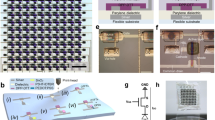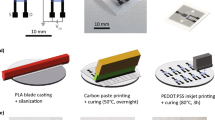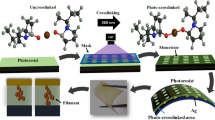Abstract
We demonstrate the direct immobilization of glucose oxidase and lactate oxidase onto photoresists commonly used in microfabrication. The method allows for a cost-effective, facile inclusion of enzyme functionality into novel MEMS devices because it does not require any chemical or physical pre-treatment of surfaces, and it is largely compatible with existing fabrication technologies. We used fluorescence imaging and absorbance spectrometry to confirm attachment of the enzymes onto the photoresists and to determine their activity. In addition, the procedure was used to successfully integrate enzyme functionality into a photoresist-based biosensor. This further demonstrates the effectiveness of the approach, and opens a path towards other novel applications in MEMS research.







Similar content being viewed by others
References
Adams JB (1991) Review: enzyme deactivation during heat processing of food-stuffs. Int J Food Sci Techn 26(1):1–20. doi:10.1111/j.1365-2621.1991.tb01136.x
Albareda-Sirvent M, Merkoçi A, Alegret S (2000) Configurations used in the design of screen-printed enzymatic biosensors. A review Sensor Actuat B Chem 69(1–2):153–163. doi:10.1016/S0925-4005(00)00536-0
Blagoi G, Keller S, Johansson A, Boisen A, Dufva M (2008) Functionalization of SU-8 photoresist surfaces with IgG proteins. Appl Surf Sci 255:2896–2902. doi:10.1016/j.apsusc.2008.08.089
Cao L, van Rantwijk F, Sheldon RA (2000) Cross-linked enzyme aggregates: a simple and effective method for the immobilization of penicillin acylase. Org Lett 2(10):1361–1364. doi:10.1021/ol005593x
Consier S (1999) Biomolecule immobilization on electrode surfaces by entrapment or attachment to electrochemically polymerized films. A review Biosens Bioelectron 14(5):443–456. doi:10.1016/S0956-5663(99)00024-X
Esquisabel A, Hernandez RM, Rodriguez Gascon A, Pedraz JL (2006) Immobilized enzymes for biomedical applications. Method Biotechn 22:283–293. doi:10.1007/978-1-59745-053-9_25
Foulds NC, Lowe CR (1986) Enzyme entrapment in electrically conducting polymers. Immobilisation of glucose oxidase in polypyrrole and its application in amperometric glucose sensors. J Chem Soc Faraday Trans 1(82):1259–1264. doi:10.1039/F19868201259
Ganesan R, Yoo SY, Choi J-H, Lee SY, Kim J-B (2008) Simple patterning of biomolecules on a diazoketo-functionalized photoresist. J Mater Chem 18(6):703–709. doi:10.1039/B709774C
Hecht HJ, Kalisz HM, Hendle J, Schmid RD, Schomburg D (1993) Crystal structure of glucose oxidase from Aspergillus niger refined at 2.3 Å resolution. J Mol Biol 229(1):153–172. doi:10.1006/jmbi.1993.1015
Heller A, Feldman B (2008) Electrochemical glucose sensors and their application in diabetes management. Chem Rev 108(7):2482–2505. doi:10.1021/cr068069y
Hirsh SL, Bilek MMM, Nosworthy NJ, Kondyurin A, dos Remedios CG, McKenzie DR (2010) A comparison of covalent immobilization and physical adsorption of a cellulose enzyme mixture. Langmuir 26(17):14380–14388. doi:10.1021/la1019845
Koeller KM, Wong C-H (2001) Enzymes for chemical synthesis. Nature 409(6817):232–240. doi:10.1038/35051706
Liang JF, Li YT, Yang VC (2000) Biomedical applications of immobilized enzymes. J Pharm Sci 89(8):979–990. doi:10.1002/1520-6017(200008)89:8
Lin S, Hwang Y, Tsai Y (1996) Immobilization of glucooligo-saccharide oxidase of Acremonium strictum for oligosaccharic acid production. Biotechnol Tech 10(1):63–68. doi:10.1007/BF00161086
Lockridge O, Massey V, Sullivan PA (1972) Mechanism of action of the flavoenzyme lactate oxidase. J Biol Chem 247(24):8096–8106
Nicolau DV, Taguchi T, Taniguchi H, Yoshikawa S (1998) Micron-sized protein patterning on diazonaphthoquinone/Novolak thin polymeric film. Langmuir 14(7):1927–1936. doi:10.1021/la970802g
Patel PD (2002) (Bio)sensors for measurement of analytes implicated in food safety: a review. TrAC 21(2):96–115. doi:10.1016/S0165-9936(01)00136-4
Perez-Luna VH, O’Brien MJ, Opperman KA, Hampton PD, Lopez GP, Klumb LA, Stayton PS (1999) Molecular recognition between genetically engineered streptavidin and surface-bound biotin. J Am Chem Soc 121(27):6469–6478. doi:10.1021/ja983984p
Pollak A, Blumenfeld H, Wax M, Baughn RL, Whitesides GM (1980) Enzyme immobilization by condensation copolymerization crosslinked polyacrylamide gels. J Am Chem Soc 102(20):6324–6336. doi:10.1021/ja00540a026
Rodriguez Couto S, Sanroman MA (2006) Application of solid-state fermentation to food industry–A review. J Food Eng 76(3):291–302. doi:10.1016/j.jfoodeng.2005.05.022
Schuhman W (2002) Amperometric enzyme biosensor based on optimized electron-transfer pathways and non-manual immobilization procedures. Rev Mol Biotechn 82(4):425–441. doi:10.1016/S1389-0352(01)00058-7
Shum AJ, Cowan M, Lähdesmäki I, Lingley A, Otis B, Parviz BA (2009) Functional modular contact lens. Proc SPIE 7397. doi: 10.1117/12.827720
Teramoto M, Nishibue H, Okuhara K, Ogawa H, Kozono H, Matsuyama H, Kajiwara K (1992) Effect of addition of polyethyleneimine on thermal stability and activity of glucose dehydrogenase. Appl Microbiol Biot 38(2):203–208. doi:10.1007/BF00174469
Thomas N, Lähdesmäki I, Parviz B (2011) Direct immobilization of enzymes on common photoresists. Tech Dig IEEE MEMS 2011, Cancun, Mexico, January 23-2007, pp 233–236
Tiina M, Sandholm M (1989) Antibacterial effect of the glucose oxidase-glucose system on food-poisoning organisms. Int J Food Microbio 8(2):165–174. doi:10.1016/0168-1605(89)90071-8
Umena Y, Yorita T, Matsuoka T, Kita A, Fukui K, Morimoto Y (2006) The crystal structure of l-lactate oxidase from Aerococcus viridians at 2.1 Å resolution reveals the mechanism of strict substrate recognition. Biochem Biophys Res Commun 350(2):249–256. doi:10.1016/j.bbrc.2006.09.025
Ward OP, Young CS (1990) Reductive biotransformations of organic compounds by cells or enzymes of yeast. Enzyme Microb Tech 12(7):482–493. doi:10.1016/0141-0229(90)90063-V
Weber PC, Ohlendorf H, Wendoloski JJ, Salemme FR (1989) Structural origins of high-affinity biotin binding to streptavidin. Science 243(4887):85–88. doi:10.1126/science.2911722
Willner I, Katz E (2000) Integration of layered redox proteins and conductive supports for bioelectronic applications. Angew Chem Int Ed 39(7):1180–1218. doi:10.1002/(SICI)1521-3773(20000403)39:7
Worsfold PJ (1995) Classification and chemical characteristics of immobilized enzymes. Pure Appl Chem 67(4):597–600. doi:10.1351/pac199567040597
Zhu Z, Momeu C, Zakhartsev M, Schwaneberg U (2006) Making glucose oxidase fit for biofuel applications by directed protein evolution. Biosens Bioelectron 21(11):2046–2051. doi:10.1016/j.bios.2005.11.018
Acknowledgments
The authors would like to thank S. McQuaide for contribution of the schematic in Fig. 3, and A. Lingley for helpful discussions about the sensor setup. In addition, the authors would like to thank A. Shum and M. Cowan for the preliminary sensor design. Furthermore, we thank the National Science Foundation for the financial support of this work.
Conflict of interest
The authors declare that they have no conflict of interest.
Author information
Authors and Affiliations
Corresponding author
Rights and permissions
About this article
Cite this article
Thomas, N., Lähdesmäki, I. & Parviz, B.A. Photoresist-based integration of enzyme functionality into MEMS. Microsyst Technol 17, 1505–1510 (2011). https://doi.org/10.1007/s00542-011-1333-8
Received:
Accepted:
Published:
Issue Date:
DOI: https://doi.org/10.1007/s00542-011-1333-8




